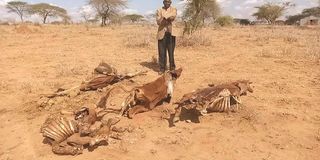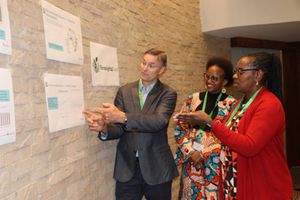Drought Diaries: Survivor tales from the dry lands of Kajiado

Amos Kitili stands next to carcasses of some of his 50 cows that succumbed to drought in Mashuru, Kajiado on October 5, 2022
What you need to know:
- During this period, more than one million animals—400,000 heads of cattle and 700,000 goats and sheep—died of hunger.
- Some 400,000 households were pushed into dependence on food aid in order to survive.
To the vast Kajiado County pastoralists, the years 2020–2022 were so catastrophic that thousands of heads of livestock died and millions more were left starving. The pangs of hunger brought many people to the brink of starvation, desperate to survive the worst drought that Kenya has experienced in 40 years.
During this period, more than one million animals - 400,000 heads of cattle and 700,000 goats and sheep – died of hunger. Some 400,000 households were pushed into dependence on food aid in order to survive.
Herders suffered losses of about Sh13 billion in a county whose economy is dependent on livestock keeping and the livestock markets of Ilbissil, Kimana, Emali and Shompole.Kenya has endured three severe droughts in the past decade: 2010-2011, 2016-2017 and 2020-2022, all of which greatly affected arid and semi-arid counties such as Kajiado.The 2020-2022 drought has been the most severe and the longest, the worst in 40 years.
In the height of the drought, a mature cow was sold for as little as Sh5,000 at Ilbisil livestock market despite the owner paying hefty charges for transportation.Mr Stephen Nkabashi, 58, from Kajiado Central, says he had more than 200 cows and at least 400 sheep and goats before the drought hit. Now he has less than 20 heads of livestock left.
"It was the worst drought in a decade. My efforts to save the animals by relocating them to neighbouring counties and buying hay bore no fruit. They died in masses from hunger and diseases,” he said, adding that he lost more than Sh8 million to the drought.
Mr Amos Kitili, 65, from Mashuru Sub-county, said he lost his entire herd of cattle to drought last year."I lost more than 50 cows last year to drought. It’s all I had. In a normal day I would have fetched more than Sh2 million in the local market." He added: “My school going children have been sent home for school fees. I cannot afford to pay, I have hit the rock bottom. I can’t breathe."
Mr Kitili’s predicament is shared across the county by many herders. Most parts of Kajiado have not received enough rainfall for the last two years. Kajiado Central, East, South and West sub-counties bear the greatest scars of the drought.
Even worse, the herders are not out of the woods yet. The March-May long rains season largely failed in the county, thereby denying the herders the much needed relief. Most parts of the vast county did not receive enough rainfall, meaning the remaining pasture might not last for long.
Mr Nkabashi said most herders are reluctant to restock their animals for fear that the drought will happen again. They are now seeking alternative sources of income such as puddle grazing. Ideally, it takes herders not less than five years to fully restock, depending on the rain pattern. "Pastoralism is no longer tenable. We have noticed the grass that has grown in the areas that received sufficient rainfall is not the usual traditional grass.
It comprises the dangerous Ipomea among other leafy plants that cannot be consumed by our animals.” Ipomea is a green leafy plant that currently grows on more than two million acres in the vast county, translating to 35 per cent of total grazing land. It has been classified as an invasive species and the county has initiated several programmes to eradicate it, but with little success.
Oliame leteti, as it is known in the Maasai language, is not eaten by both wild and domestic animals due to its awful smell. The plant has also affected honey production in the region. Bees that collect nectar from the plant’s flowers are believed to produce poisonous honey, hence tanking the price of honey.
In some regions, signs of another drought have already started showing. Last week more than 800 women from Murtot location, Kajiado South, held a peaceful protest, claiming that more than 7,000 families in the area were starving and no one was helping them.
The county government of Kajiado under the department of Agriculture, Livestock Development and Fisheries is currently moving in earnest to roll out a modulated pastoralism for sustainable livelihoods programme among pastoralists.

Amos Kitili stands next to carcasses of some of his 50 cows that succumbed to drought in Mashuru, Kajiado on October 5, 2022
This is basically educating and training locals on profitable livestock keeping, a break from traditional nomadism. Under the programme, farmers will be grouped into cooperatives to ensure they cushion themselves from individual losses. Cooperatives will train them on feed and fodder production and market their products.
Kajiado Governor Joseph Lenku said residents ought to view pastoralism not only as part of their culture, but also as a modern generator of adequate household income.
"Our livestock must mature faster, produce higher quantities of quality milk, beef, hides, and skins, among other products, and we must access better markets for our livestock products,” he said, adding that food security remains a key area of concern. The county will also be seeking to promote small scale food production in urban and peri-urban areas and effect the town's spatial plan to identify which activities should be carried out in specific areas.
He added that:" The cooperative movement has been a major contributor to economic growth in progressive societies. Incidentally, this concept has not been fully embraced in our county, where we have 527 active cooperatives, with Kajiado North having the highest at 160 and Kajiado West having the least at 62."
Further the county has set aside Sh250 million for an upcoming County Aggregation Industrial Park, for which the national government has offered Sh250 million to boost livestock product value chains in the county.





